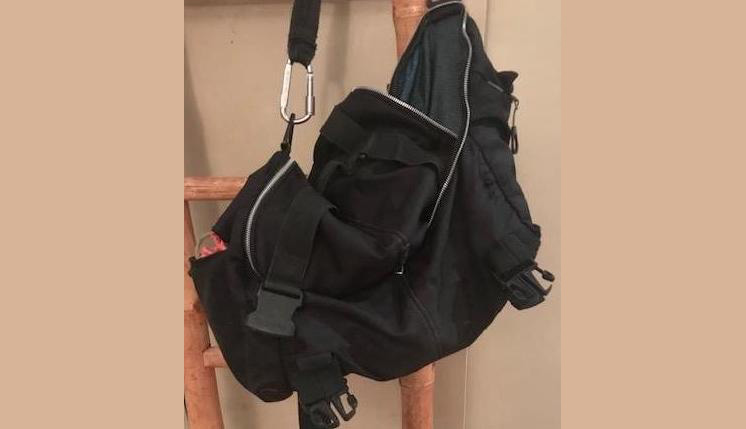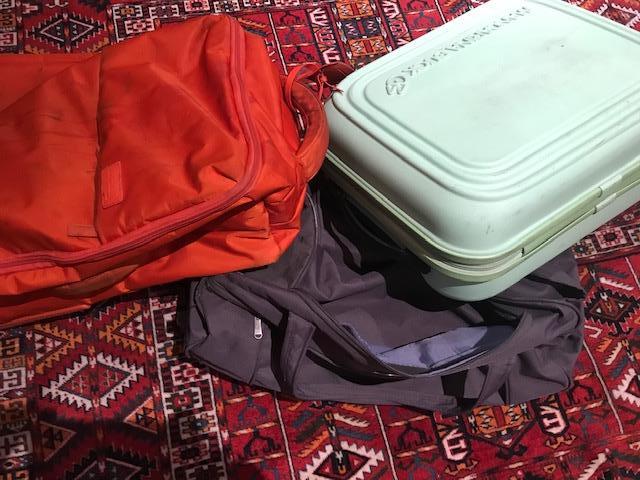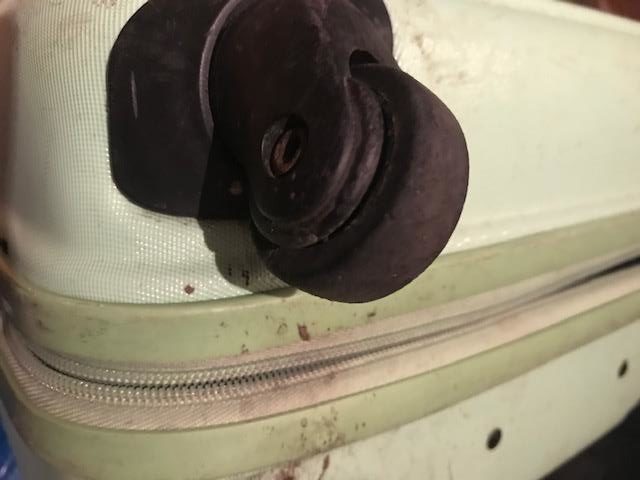Che fare della mia valigia ora che non viaggio più? Dritte per cambiarla e scoprirla
La valigia è lo specchio del processo evolutivo della specie. Ora che è ferma e vuota, proviamo a reinventarla.

La valigia è lo specchio del processo evolutivo della specie. Ora che è ferma e vuota, proviamo a reinventarla.

(English version below)
La mia valigia si è afflosciata come un sacco sgonfio. In questi mesi senza missioni di lavoro, se ne resta inutilizzata su uno scaffale. Alcune cose sono dentro sempre pronte – la mascherina per dormire in aereo, il caricatore del telefono e l’adattatore, una penna, una piccola borsa di tela piegata – ma in questi mesi di forzata inattività è diventata quasi un oggetto inutile rispetto ai periodi nei quali viene riempita e svuotata quasi ogni sera, da un albergo all’altro. La guardo e penso che “devo fare qualcosa con la mia valigia”. Magari cambiarla, approfittando delle occasioni in giro, visto che anche negozianti e produttori di valigie sono stati colti a sorpresa dalla pandemia, essendo un anello dell’industria del turismo e del trasporto.
Saprei cosa cercare, e cosa consigliare, avendo idee chiare in fatto di valigie: colore nero (nasconde meglio usura e sporco), di buona marca (su qualità e solidità della valigia non si risparmia), non rigida e anzi comprimibile o estensibile a seconda di quanta roba ci sia dentro, perché così si adatta a molti spazi nei quali va riposta; e tracolla anziché ruote. Diverse ragioni giustificano quest’ultimo criterio, poco popolare e controverso: ormai i carrellini ci sono quasi dappertutto e le ruote dei trolley in aeroporto non servono più, inoltre fa parte (masochisticamente) dello spirito del viaggio sentire il peso del bagaglio sulle spalle, e infine proprio la sostenibilità del peso ci obbliga ad evitare fronzoli e portare solo il necessario.
Ma io non la cambierò, appartengo alla categoria di viaggiatori che usano sempre la stessa valigia, facendola riparare se si rompe una cerniera o un gancio, mentre ad altri piace cambiare spesso il proprio bagaglio.
Il mancato uso delle nostre valigie aiuta comunque tutti a riflettere su questo oggetto feticcio, non molto diverso dalla borsa della donna o dalla ventiquattrore del professionista, ormai spesso sostituita dalla borsa per il pc: quasi un marchio di fabbrica personale, perché dentro ci portiamo un pezzo di casa nostra, dell’ufficio, di noi stessi.
La valigia ci induce ad alcuni piccoli riti privati: come disporre le cose, quando la si prepara – la sera prima della partenza, il giorno prima, all’ultimo momento. Non me la lascerei mai preparare da un’altra persona, ma altri hanno abitudini diverse e deve essere il proprio partner, come un tempo era magari la mamma, a riempirla.
In famiglia ne ho alcuni esempi. Alla nostra valigia è legata una tempistica ormai codificata: la preparo in anticipo, ma la svuoto subito quando entro in una camera d’albergo, e anche quando torno a casa. È la prima cosa che devo fare, poi viene il resto. Un ex ministro degli esteri del Belgio e commissario europeo, mi confidò che quando torna da una missione, non solo non lascia aprire a nessuno la sua valigia e la apre di persona, ma subito, come estensione di questa apertura, ha il bisogno di mettersi a stirare gli abiti ancora puliti che vi tira fuori: “È un modo per effettuare il passaggio dalla valigia all’armadio, dal viaggio alla casa, un piccolo esercizio riposante”, mi ha più o meno detto.
Questo oggetto non è banale. C’è chi lo vuole di pelle o in tessuto sintetico e impermeabile, con la griffe ben evidente o discreto, eccetera, e quando le vediamo uscire dai caroselli della consegna bagagli degli aeroporti, appaiono per quelle che sono: misura ormai standardizzata, tutte simili, a volte quasi uguali, ma ognuna con un che di proprio che la rende inconfondibile, quasi un trait d’ésprit del proprietario; e infatti, di confondere la propria valigia con un’altra accade davvero raramente, pur così tutte simili.

Questo periodo di forzata inattività è l’occasione per ricordare la storia di questo oggetto personale e così diffuso. Non sono uno storico della valigeria, mi limito a una grossolana cronologia, che avrà le sue imprecisioni – e in rete si trovano alcune panoramiche storiche, soprattutto in siti di produttori o perfino in quello di un deposito bagagli di Firenze.
Da quel che so, all’inizio era la bisaccia. Una tracolla, un panno che raccoglieva le poche cose del viaggiatore e in questo modo si è andati avanti per secoli. Chi aveva esigenze maggiori si doveva fornire di un baule, la cui origine è antichissima. Ci sono voluti secoli prima di riformare la bisaccia nello zaino, invenzione con scopi militari: disporre il peso su due cinghie e quindi sulle due spalle, permette meno fatica e maggiore agevolezza, quasi la scoperta dell’acqua calda, e ci si chiede per quale ragione ci sia voluto così tanto tempo prima di arrivarci. È circa nel Settecento che un altro anonimo inventore trasforma il baule in qualcosa di più agevole: dimensione molto minore e una maniglia che lo renda afferrabile da una sola persona – nasce finalmente la valigia. Cambiano i materiali, le taglie, ma non il concetto, che resta inalterato fino agli anni Ottanta del XX secolo, appena ieri. Un pilota di linea americano si cimenta nel laboratorio di casa in un esperimento tutto personale: applicare due piccole ruote alla sua valigia e dotarla di un’asta per trascinarla.

La trovata ha un immediato successo presso i colleghi piloti, che gli chiedono di modificare le proprie valigie con l’aggiunta delle ruote. L’idea non è brevettata, in molti cominciano a produrre le valigie mobili in scala industriale, anche lo stesso pilota che cambia lavoro e avvia una prospera attività. Oggi il trolley è la norma, frutto dell’incontro di due scoperte elementari: la ruota e la valigia, ovvero un carrellino e un baule piccolo con maniglia. Nessun laboratorio di nanotecnologia è stato necessario per queste redditizie invenzioni, nessun finanziamento: l’idea giusta era sotto il naso di tutti, lo è stata per secoli senza che nessuno ci pensasse. Ogni svolta è avvenuta non da geniali scienziati, ma da viaggiatori o artigiani più o meno anonimi che hanno affinato il loro spirito di osservazione e la capacità di formulare congetture evidenti ma, evidentemente, a prima vista nascoste.
La valigia, insomma, racchiude una sorta di processo evolutivo della nostra specie ed è verosimile che un altro semplice miglioramento sia dietro l’angolo in attesa che qualche mente libera ci pensi. Forse è adesso che, finalmente fermi dinanzi alle nostre valigie anch’esse ferme, ci verrà in mente qualcosa.
ENGLISH VERSION
My suitcase has collapsed like a deflated bag. In these months without job missions, it remains unused on a shelf. Some things are always ready inside – the mask for sleeping on the plane, the phone charger and the adapter, a pen, a small folded canvas bag. Yet, in these months of forced inactivity, it has become almost a useless object compared to when it was filled and emptied almost every evening, from hotel to hotel. I look at it and I think “I have to do something with my suitcase”. Maybe change it, taking advantage of the opportunities around, since luggage shops and manufacturers are also victims of the pandemic. I know what to look for, and what to recommend, I have clear ideas on suitcases: black color (it better covers dirt), of good brand (no saving on quality of suitcase), not rigid material but flexible and extensible depending on how much stuff is in it, because so it adapts to many spaces in which it is stored; and shoulder strap instead of wheels. Several reasons justify this last criterion, which is not very popular since trolleys are so popular: but airports have now trolley available for transit and moreover the feeling of the weight of the luggage on our shoulders it is (masochistically) part of the spirit of travel, and eventually the sustainability of the weight forces us to avoid frills and to bring only the necessary.
Anyway I will not change it, I belong to the category of travelers who always use the same suitcase, preferring to repairing a broken zipper or hook, while others like to change their luggage often. The current non-use of our suitcases, however, makes us to look on and reflect on this fetish object, not very different from the woman’s bag or the professional’s briefcase, now often replaced by the laptop bag. It is almost a personal trademark, because inside we carry a piece of our home, of the office, of ourselves. The suitcase leads us to some small private rituals: how to arrange things, when preparing it – the evening before departure, the day before, at the last moment. I would never let another person prepare it, while others, even frequent travellers, and it is the partner who must fill it, as perhaps once was the mum.
Our suitcase is linked to a timeframe that is now codified: I prepare it in advance, and I empty it immediately when I enter a hotel room, and also when I return home. It is the first thing I have to do, then the rest comes. A former Belgian foreign minister and European commissioner, told me that when he returns from a mission, not only he does not let anyone open his suitcase and opens it in person, but immediately, as an extension of this opening, he needs to start ironing his clothes just taken back home: “It’s a way to make the transition from the suitcase to the wardrobe, from the trip to the house, a little relaxing exercise”, he said.
A suitcase is not a trivial object. There are those who want it in leather or in synthetic and waterproof fabric, with the brand name very evident or discreet, etc., and when we see them coming out of the airport belt baggage delivery, they appear for what they are: all in standardized size and similar, often very much alike, but each with something of its own that makes it unmistakable, almost a trait d’ésprit of the owner. In fact, it happens very rarely to confuse one’s suitcase with another, even though they are all similar.
This period of forced inactivity is an opportunity to remember the history of this personal and so widespread object. Bot being a historian of luggage, I limit myself to a rough chronology, which will have its inaccuracies – on internet there few historical overviews, especially in producers’ websites or even in that of a luggage storage in Florence ().
From what I know, in the beginning it was the saddlebag. A shoulder strap, a cloth that collected the traveler’s few things. It went on for centuries like this. Those who had greater needs had to provide a trunk, whose origin is very ancient. It took centuries before reforming the saddlebag into the backpack, an invention with military purposes: placing the weight on two straps and therefore on the two shoulders, allows less effort and greater ease, almost the discovery of hot water, and one wonders for which reason it took so long to get there. It was around the eighteenth century that another anonymous inventor transformed the trunk into something easier: a much smaller size box with a handle that made it manageable by one person – the suitcase was finally born. The materials and sizes change, but the concept remains unchanged until the eighties of the twentieth century – just yesterday. An American airline pilot tries in his home laboratory a small personal experiment: he applies two small wheels to his suitcase and equips it with a rod to drag it. The idea was immediately successful with fellow colleagues, who asked him to modify their suitcases with the addition of wheels. The idea was not patented, many begin to produce “mobile suitcases” on an industrial scale, even the same pilot who changed jobs and started a prosperous business. Today the trolley is the norm, the result of the meeting of two elementary discoveries: the wheel and the suitcase, or rather a trolley and a small trunk with handle. No nanotechnology laboratory was needed for these profitable inventions, no special funding: the right idea was under everyone’s nose, it has been there for centuries without anyone thinking about it. Each turning step of the evolution of the suitcase took place not because of brilliant scientists, but due to anonymous travelers or artisans who have refined their spirit of observation and their ability to find obvious formula that, evidently, for so long nobody got.
The suitcase, in short, contains a sort of evolutionary process of our specie and it is likely that another simple improvement is around the corner waiting for some free mind to think about it. Perhaps it is now, in those months of no movement, seating in front of our unused suitcases, that something new will come to mind.
Niccolò Rinaldi
